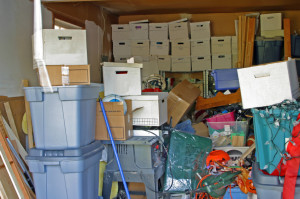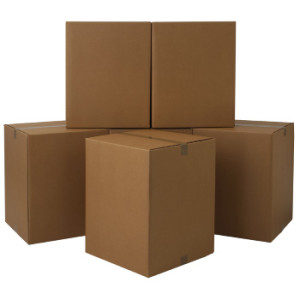
Does this junk pile look familiar? Don't relocate with stuff you don't need.
By Kathy Woodard
So, you finally found the perfect home, congratulations! The next step is planning for your big moving day, and the first thing you need to think about is packing. While packing for a move, getting rid of unneeded or unwanted belongings can save you time, money and a whole lot of aggravation. Here are some great ideas for The Great De-Clutter!
Room by room:
Most of us have a whole houseful of clutter that we don’t even realize we move! It can feel overwhelming to consider everything you need to go through, so start by breaking it down into smaller jobs. Sort through each room one at a time; don’t try to tackle the whole house in a weekend. Plan ahead and give yourself plenty of time to decide what’s worth keeping, and what needs a new home. Have three piles; one for trash, one for give away, and one for packing. When you finally get through all the rooms, move all your give away piles into a garage or empty floor space, and begin the de-cluttering! Here’s what to do with all that stuff…
Sell it:
Lots of the things you no longer want may be old for you, but may be a great find for someone else. And guess what; they may be willing to pay you for it. Items often in demand are electronic equipment, furniture, books, entertainment and items of value, such as jewelry. You may even sell enough stuff to help pay for your move! Great ways to find buyers for your unneeded belongings:
- Craigslist.com
- Local classified newspaper
- Bulletin boards at apartments, churches, and health clubs
- Social networking sites like Facebook and Twitter
- Friends and family
Speaking of friends and family…
Many times the people you love the most have similar tastes and needs as you. They may have had their eye on that dog painting above your fireplace for years, and now is their chance! Host a “Moving On” party. Move all your give away items to a garage space, a yard, or an unused room. Now invite all your friends and family for pot luck, inviting them to bring both a dish, and plenty of extra space in the car for the ride home A good time to be had by all, and everyone gets to pick and choose what they would like. Everyone wins!
In the case that not all your treasures are snapped up by those who know you best…
Give it away
There are many benefits to donating items you no longer need, or just plain don’t want to pack. Donating so items can be reused is environmentally responsible, can give you a tax savings and most of all, will help you to accomplish the main objective… de-cluttering! Many charities will even come to your door and pick up for free. When you have sold all you can sell, and given away as much as you can to family and friends, this is your next step. Make sure to get (and save) a receipt from the charity you choose to donate to so you can deduct the value from your taxes. You might want to call several weeks in advance of your move if you want to get a pick up; some charities book far in advance for those services. Here are some great ideas for charities to donate to, but there are many more. Check your local phone book, or ask at a local church for more ideas.
Also, consider the website Freecycle.com. You can post your items to give away in your local area, just like on Craigslist. Things tend to get snatched up pretty quickly, so it’s a good place to try if you can’t wait for a charity pick up.
Getting rid of your belongings while packing for a move is a necessity not only for the packing process, but to help you enjoy your new home as well. After all, why start over in a new home with all your old stuff? On top of all that, having a little less stuff is sure to save you on some money when using movers.
Want free home and garden ideas? Kathy Woodard, is an author, columnist and home decorating expert. Visit her at her website www.TheBudgetDecorator.com and also at www.DecoratingYourSmallSpace.com.
 To save money on their relocation, many people are doing their own packing.
To save money on their relocation, many people are doing their own packing.
However, this can be a source of confusion and problems with moving companies when it comes to moving day — and it could cost you.
Moving companies want to be able to move things as quickly as possible out of your house and get it on the moving truck. Once on the truck, they need to be able to load thSAe truck like they’re putting together a puzzle so your items fit snugly.
The easiest way to do this is by using uniform, sturdy moving boxes.
Not only does this make the move go more smoothly and efficiently, it also cuts down on the risk of damage to your items, because a box is just a more stable way of moving things with less risk of dropping it.
So if it can go in a box, put it in a box.
If it’s not in a box, the movers will box it for you on moving day – and charge you for it, creating a sometimes hefty extra charge you hadn’t planned for.
We’ve created a list of items that customers often incorrectly leave unboxed. It’s generally anything that cannot be stacked evenly when loading the truck — for example, a statue that cannot be square with the stacked boxes.
* Clothes: Many people will put these in trash bags. They need to go in boxes. Trash bags easily rip and create a mess and they don’t stack neatly in the moving van.
* Stools and furniture small enough to fit into a box
* Lamps and shades
* Throw pillows and bedding
* Small rugs
* Fireplace equipment
* Tools
* Pictures and paintings
* Curtains and window treatments
* Children’s toys
* Vases and planters
Also, don’t try to pack items in small boxes. Some customers will pack things in shoe boxes, or they’ll pack collectibles like figurines into their original packaging.
It’s fine to do that, but those small boxes are a hassle for your mover to carry, they’re easy to drop, and they can’t be stacked neatly on the moving van. So consolidate them into a larger moving box.
Related Stories:
One of the biggest challenges on move day is setting up your electronics at your new place. It’s a long list these days:
• Find a provider for your phone, Internet, cable TV and cell phone
• Hook up your TV entertainment system
• Set up the network for your computer — both your Internet access and any networking system if there are multiple computers in your home.
It’s important to plan this well BEFORE you move, because during your move-in, you’ll be dealing with a cat that keeps trying to escape its new home, a crying toddler, and boxes packed to the sky.
To ease your pain (and make some more money), some movers are teaming up electronics shops to offer this service as part of your move.
For example, moving behemoth Mayflower has teamed up with Best Buy’s “Geek Squad” to offer setup for your PC and home theater system. There are also businesses and individuals who will set these up for you (for a fee, of course).
If you choose to do it alone, here are some helping hints for moving electronics
* When you disconnect wires, label them so you know where they connect. I know, they’re usually handily labeled according to color, but even a simple numbering sytem (1 to 1, 2 to 2), which help you set everything up quickly when you get to your new place.
* Take a picture of the assembly as it is now. When you move into your new place, you’ll just need to take a look at the picture to see what goes where. Don’t assume you’ll remember. I thought I would when I moved. I ended up connecting my DVD Player to the microwave.
* Keep all common wires and parts together – just put them in a simple plastic baggie, and then tape that bag to the component itself or have it in the same box as the component. Be sure to label the bag as well.
These articles can help you determine which home services you want at your new place.
Many people struggle over how to pack fragile items — glass items, picture frames, that beloved neon beer sign from college.
Here’s a suggestion: stop worrying about it and have the moving company pack it. You’ll pay for it, of course, but you could end up saving in the long run.
How?
When you pack items yourself and the items inside get broken, you won’t be covered by insurance. That’s right. All the bubble wrap and good intentions in the world won’t protect that awesome ceramic cat if it gets broken in a box that you packed yourself.
Unless the box itself has visible damage and was obviously dropped or somehow damaged in the move itself by the moving company, the only coverage you’ll have is the minimum valuation that moving companies are required to provide: 30 cents per pound for local moves, 60 cents for long distance moves. That won’t go far in replacing the item.
Here’s another sobering fact: You’re bad at packing. Oh sure, you’ve moved 3 times and like to think yourself a whiz with tape and those little syrofoam peanuts.
But you’re not that good. Sorry. And even if you are good, you’re not as a good as a guy who does it full-time, every day, every week of the year.
But in the end, it’s not about who’s the best: it’s about what happens if something gets broken. And if something does, it might be the best route to make sure your items are protected by insurance.
For more information about insuring your move, check out this article on moving insurance. This article can help you learn how to pack fragile items.